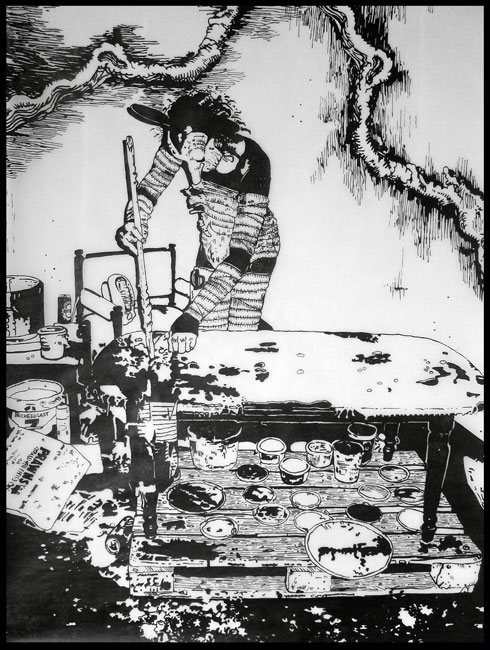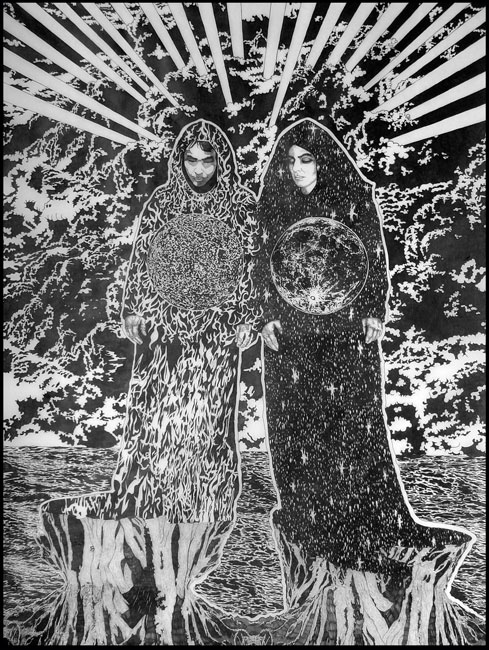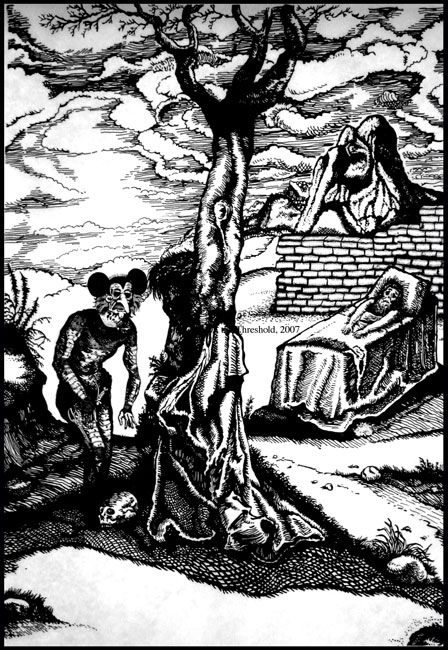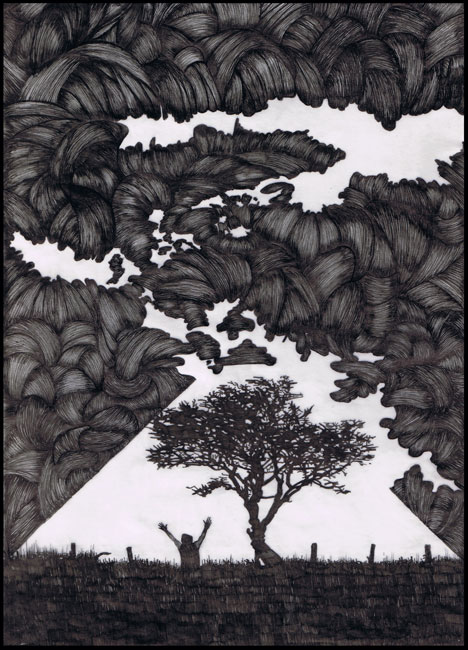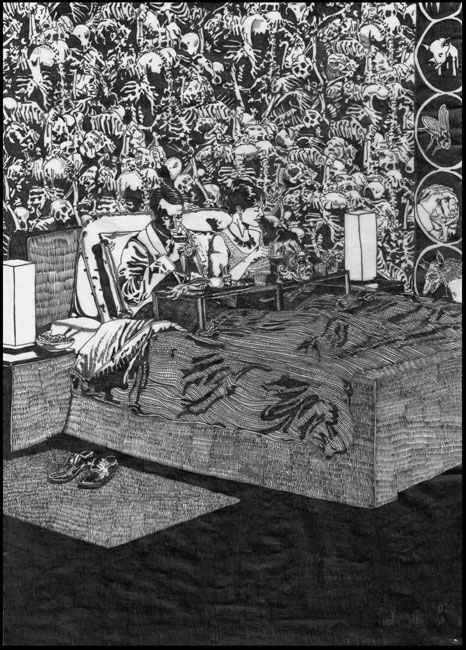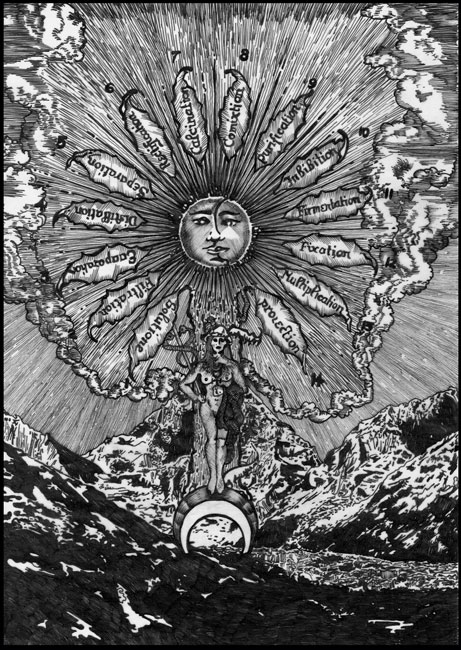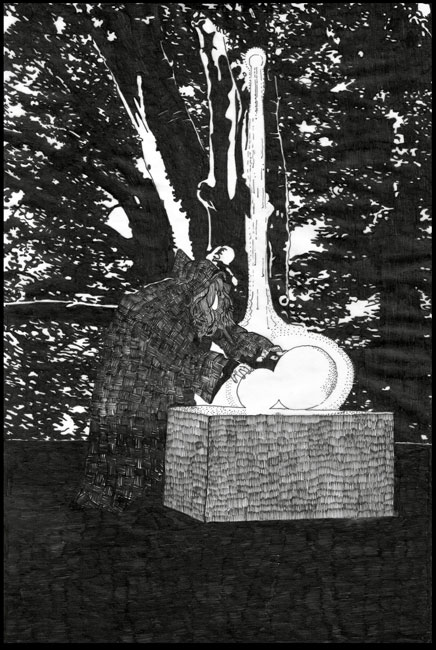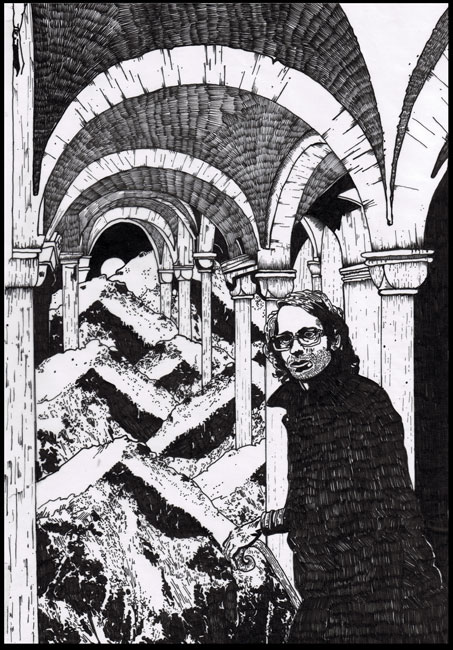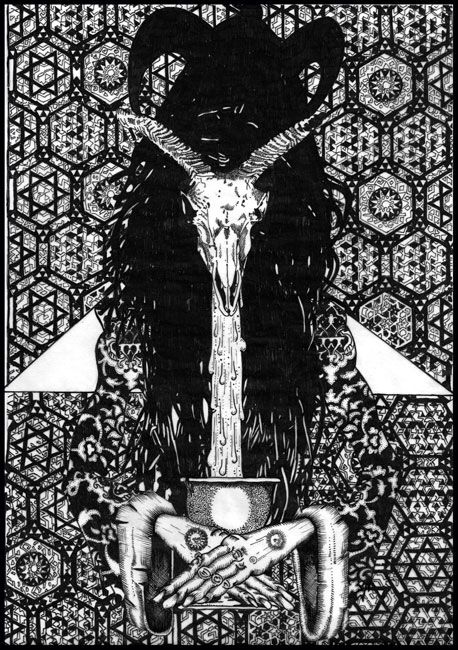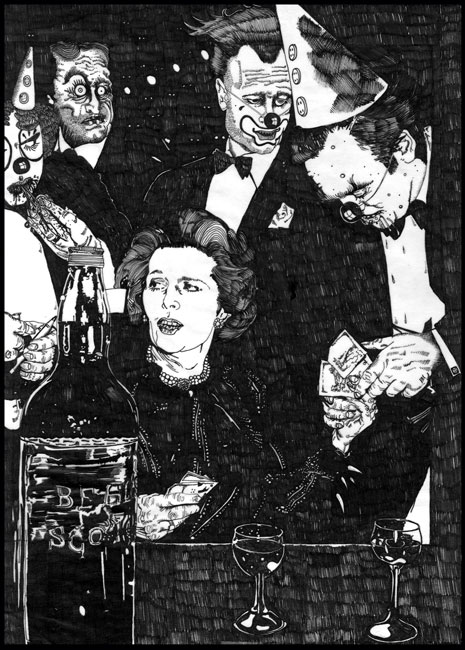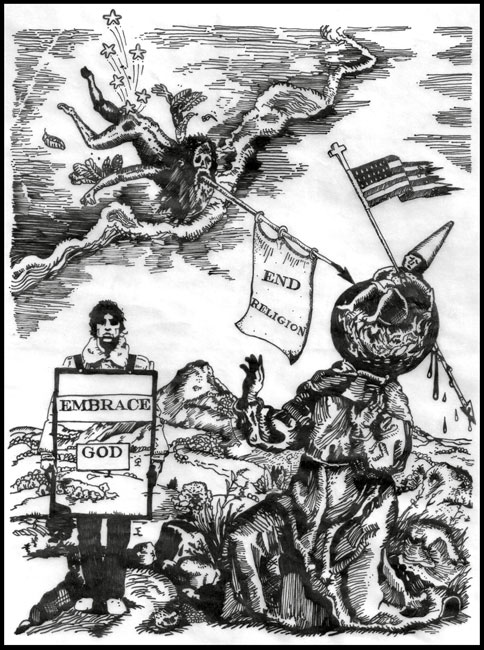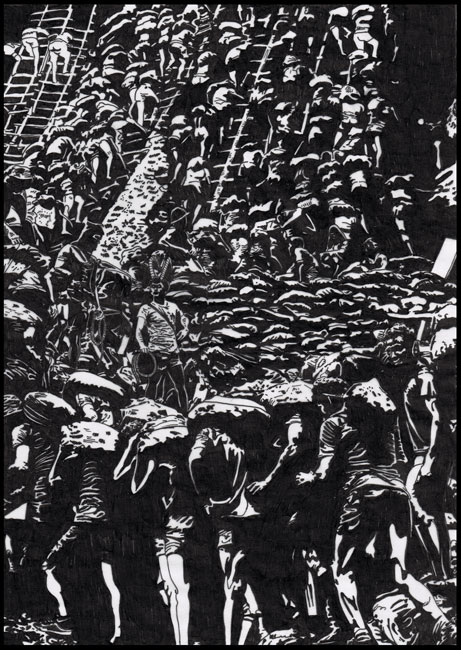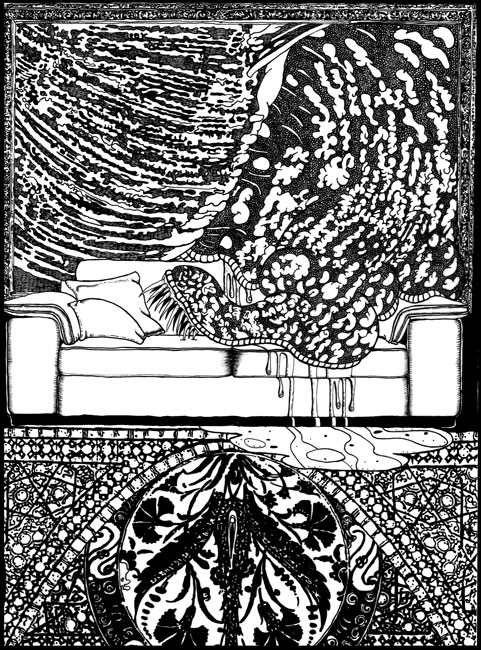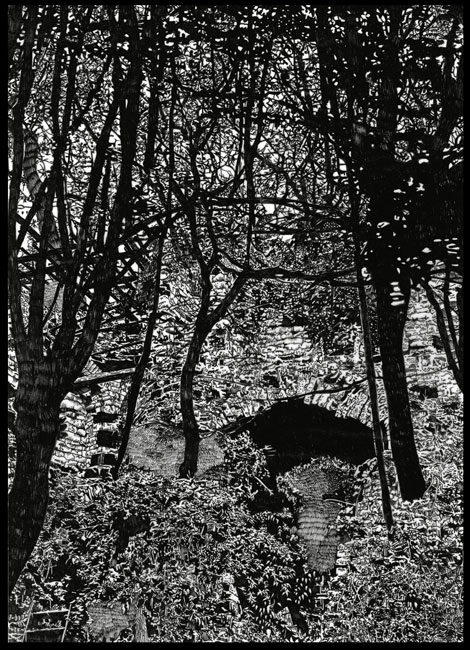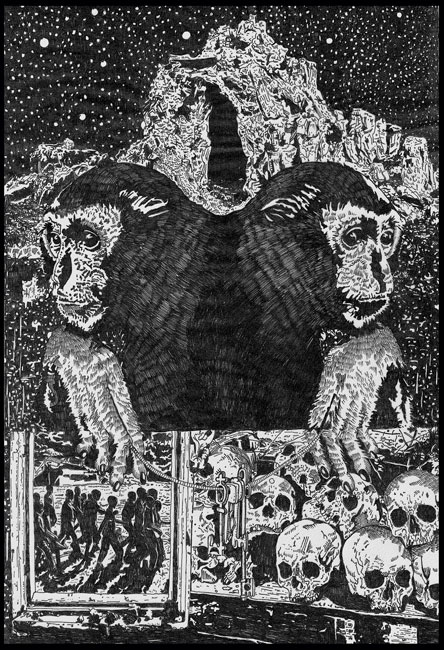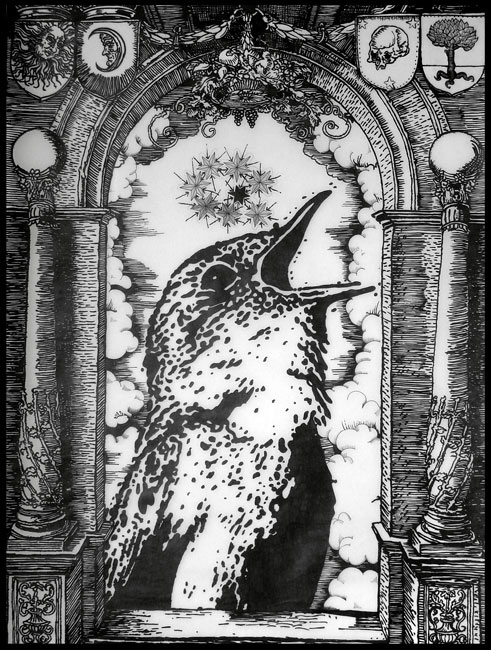Palli Banine (1972) is an Icelandic visual artist, now living and working in Brussels. He holds a BFA degree from the Icelandic Academy Of The Arts (Mixed Media department) and an MA from the Transmedia department of Sint Lukas, Brussels.
Palli uses many mediums in his work, including performance, installation, sculpture and drawing. He exhibits regularly and his work has been shown in China, Canada, Germany, Denmark, Holland, Belgium and Iceland. Palli was an active member of the seminal Icelandic artist collective Klink&Bank from 2003 to 2005, where he exhibited and curated shows. There, he also collaborated and assisted with projects by visiting artists, including Paul McCarthy, Jason Rhoades, Christophe Schlingensief, and John Bock. Since 2001, Palli has also been a member of the Dieter Roth Academy, an association of artists that hosts an annual exhibition and conference to honour the memory of Dieter Roth.
Palli is currently working on a series of drawings loosely inspired by Goya's 'Los Caprichos'. His method is to collect 'abandoned' images from various sources (often flyers, newspapers or other disposable prints). He then attempts to rejuvenate them, and in the process transforms them far from their original purpose and meaning. The results are multilayered, detailed drawings that experiment with narrative. The drawings contain hints of stories (often through the use of recognisable symbols and motifs) which address and activate the audience's inherent sense of myth.
Ceremony, 2009
This drawing features myself, and is connected with my thoughts of re-using or recycling images. Just as you would recycle paper, I recycle images, forgotten adverts, flyers and such - and in this particular drawing I decided to recycle, or re-use, or use to the fullest, a documentation image of myself doing one of my performances. My thought was that I spend a lot of effort documenting my work, both on video and in photos, and then this effort goes into my computer and stays there collecting digital dust and pixilated cobwebs. So I decided to use one of these photos as a source image for a drawing. Transforming a living action into a photo, and then from the photo into a drawing, takes the original idea back in time through the mediums - drawing being the oldest and digital photos being the newest medium.
It was also an experiment in self-Mythologizing. When I see how I can be 'sent back in time', it seemed to create a snapshot of a forgotten or unknown religious ceremony - hence the title. |
|
Ceremony, 2009
In deze tekening figureer ik zelf, en ze is verbonden met mijn gedachten over het hergebruik of recycleren van beelden. Net zoals je zou papier zou recycleren, recycleer ik beelden, vergeten advertenties, folders en dergelijke - en in deze specifieke tekening heb ik besloten om een documentatiebeeld van mezelf tijdens een van mijn optredens te recycleren, of te hergebruiken, of tot het uiterste te gebruiken. Mijn idee was dat ik veel moeite doe om mijn werk te documenteren, zowel op video als in foto's, en dan wordt die inspanning in mijn computer gestopt en verzamelt er digitaal stof en gepixelleerde spinnenwebben. Dus besloot ik om een van deze foto's als basis voor een tekening te gebruiken. Het transformeren van een levende actie in een foto, en vervolgens van een foto in een tekening, neemt het oorspronkelijke idee terug in de tijd via de verschillende media – het tekenen is daarbij het oudste en de digitale fotografie het nieuwste medium.
Het was ook een experiment in zelf-mythologisering. Als ik zie hoe ik kan worden 'teruggestuurd in de tijd', het leek een momentopname van een vergeten of onbekende religieuze ceremonie te creëren - vandaar de titel. |
| |
|
|
The Good Old Boys, 2010
The work is about many things.
One of them being the sad and real fact that it seems to be the old who always send the young of to die in wars they come up with and almost always for shitty reasons.
In smoky rooms in mens clubs all across the world old men(Good old boy's) sit and dream up wars for the young to die in. The invasion of Iraq is a good example of this, where the whole western world is dragged in to a war of profit for a few elitist corporations, the Carlyle group, Halliburton, these are a few names worth mentioning, arms manufacturers and big oil companies, send young people starved of education and opportunities in to war in places they can't understand, confronting cultures they have no idea about, to die for money. This is demonic by any standard and should be dealt with as such.
I recently visited the Flanders fields and was horrified and disgusted at the pointless waste of life in a war that was supposed to end all wars, well that did not happen did it ? No it gave birth to an even bigger war and that war did not end anything either (violence begets violence), in fact we are still living with the ghosts of the second world war.
Big corporations like Nike (represented in the drawing) are using children in third world countries like slaves to make more money, this of course is terrible for the youth of the countries that indulge in child labour but it makes the corporations more money to use children they don't have to pay (evil). In fact they behave like insane children them self's. Capitalism is the system we live in and it can work, the thing is that there seems to be no control just look at the recent recession ! like the Frankenstein monster this thing is alive and dictating our lives to us,like an rampaging monster it eats away at society, and all the while the people that play in the capitalistic system talk about it like the weather? There is going to be storm here a little rain there, it's all just smoke, economics is not like the weather you count what goes out and you count what comes in and you compare the two, it's only when greed injects it self in to the system
that you have it go of balance like a runaway train,because enough is never enough, there is no end.
Shame on the monsters that know not that they are monsters they only know what they do.....and it's no good, the players in this game never have to look at the consequences of there actions or deal with the horror they create (Hitler never visited Auschwitz).
There is a lot more to be said about 'The Good Old Boys' but I hope this will do for now. In short it's about the old killing the young for money....like vampires they need the uneducated and ignorant to fill up there war machine, they well deserve the image I have given them,but like i said in the beginning the work is about this and a lot of other things. Right now in a mansion in Hell'The Good Old Boys'are having a cigar and a Whiskey and conjuring up a new nightmare for the world,
just so they can see the numbers on there secretaries laptops rise.
I hope this is enough for now, let me know if there is something else,
and if something happens with the show. |
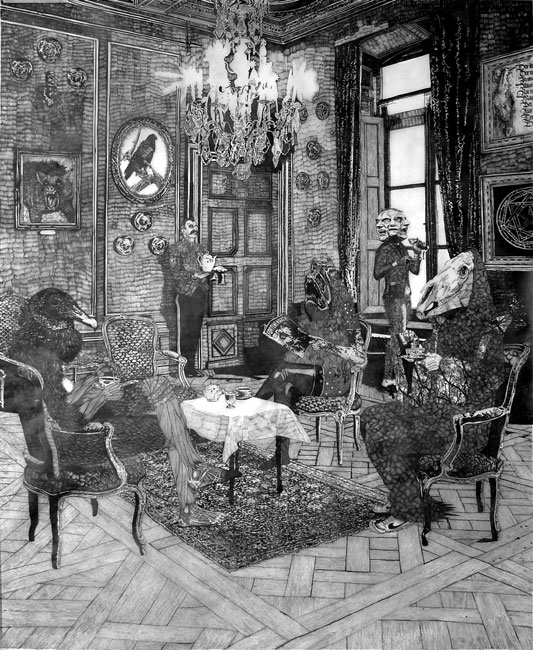 |
The Good Old Boys, 2010 |
| |
|
|
The Gemini, 2009
The Gemini s a double self-portrait, and the first one I have ever made. The thought behind it comes from my Alchemical studies of the elements, which are all represented in the drawing. Air, Fire, Water and Earth are all part of the composition - as well as the fifth element, the human element.
I follow the dialogue about the state of the planet - subject matters such as global warming and fossil fuels are of importance to me. I have come to recognise that the human presence on the earth can truly be considered the fifth element, since our consumption and working of the earths resources could be felt as an active force equivalent to the Atlantic Ocean or any other large natural phenomenon. When all the aspects of human presence on earth are collected together the effect is enormous. This is one aspect of the drawing. It is also an homage to the Alchemical notion of balance, which I imagine in its environmental aspect.
The male and the female elements within the human psyche also need to be balanced, especially for those of us who have creative inclinations. A friend of mine said once to me that all works of art are virgin births - this comment was of great interest to me. In The Gemini my male (fire-sun-day-gold) and female (dark-moon-night-silver) aspects are seen together standing on the earth.
|
|
The Gemini, 2009
The Gemini is een dubbel zelfportret, en het eerste dat ik ooit heb gemaakt. De achterliggende gedachte komt voort uit mijn Alchemistische studies van de elementen, die alle vertegenwoordigd zijn in de tekening. Lucht, Vuur, Water en Aarde maken allemaal deel uit van de compositie - evenals het vijfde element, de menselijke factor.
Ik volg de dialoog over de toestand van de planeet - onderwerpen zoals de opwarming van de aarde en fossiele brandstoffen zijn van belang voor mij. Ik ben tot het besef gekomen dat de menselijke aanwezigheid op aarde werkelijk als het vijfde element kan worden beschouwd, aangezien onze consumptie en het verwerken van de grondstoffen van de aarde kan worden gezien als een actieve kracht die gelijk is aan de Atlantische Oceaan of aan welk ander groot natuurlijk fenomeen dan ook. Wanneer alle aspecten van de menselijke aanwezigheid op aarde worden bijeengevoegd dan is het effect enorm. Dit is één aspect van de tekening. Het is ook een hommage aan de Alchemistische notie van evenwicht, die ik me voorstel als milieuaspect.
De mannelijke en vrouwelijke elementen binnen de menselijke psyche moeten ook in evenwicht worden gebracht, vooral voor diegenen onder ons die creatieve neigingen hebben. Een vriend van mij zei eens dat alle kunstwerken maagdelijke geboorten zijn – die uitspraak was van groot belang voor mij. In The Gemini staan mijn mannelijke (vuur-zon-dag-goud) en vrouwelijke (donker-maan-nacht-zilver) aspecten samen op de aarde.
|
| |
|
|
The Prayerer on the Threshold, 2007
Here is the same character that is seen in Ceremony, except he’s been put even further back in time. The background image is similar to those from the Alchemical manuscripts, a cryptic image done in a certain style. I was playing with the notion of putting a contemporary looking figure into a mysterious medieval image - a kind of historical blunder, inspired from Renaissance paintings with flying saucers in them (yes they exist). I have a deep interest in Archaeology and particularly in its mysteries. |
|
The Prayerer on the Threshold, 2007
Hier is hetzelfde personage dat is te zien in Ceremony, behalve dat hij nog verder terug in de tijd is gezet. De achtergrondafbeelding is vergelijkbaar met die van de Alchemistische manuscripten, een cryptisch beeld in een bepaalde stijl. Ik speelde met het idee van een eigentijds ogend personage neer te zetten in een mysterieus middeleeuws beeld - een soort van historische blunder, geïnspireerd door de Renaissance schilderijen met vliegende schotels (ja ze bestaan). Ik heb een diepe interesse in archeologie en in het bijzonder in haar mysteries.
|
| |
|
|
Spring Rite, 2010
Spring Rite is, as the title says, a celebration of spring and of life in the form of a tree. It is a nod to the Tree of Life, which is a sacred and ancient symbol and is in many of my works, for instance The Prayerer on the Threshold, and The Song in the Temple. Although the image could be considered quite gothic, its subject matter could not be more positive. Choosing between the first tree to bloom after winter or the one that never lost its leaves, I would go for the later. |
|
Spring Rite, 2010
Spring Rite is, zoals de titel al zegt, een viering van de lente en van het leven in de vorm van een boom. Het is een knipoog naar de levensboom, die een heilig en oud symbool is dat in veel van mijn werken voorkomt, bijvoorbeeld in de The Prayerer on the Threshold, en The Song in the Temple. Hoewel het beeld als vrij gotisch zou kunnen worden beschouwd, kan het onderwerp niet positiever zijn. Als ik moest kiezen tussen de eerste boom die bloeit na de winter of degene die nooit zijn bladeren verliest, dan zou ik voor de laatste gaan. |
| |
|
|
The New Cannibals, 2008
The New Cannibals is about certain lifestyles in the west, which are actually promoting misery in what we in the west call the third world. In my mind there is only one world and we are all in it. The image is about consumption, the consumption of the planet, its peoples, and resources to feed a shallow and meaningless lifestyle. Tuberculosis is also called consumption because it consumes the body and kills its host. I see the way the west is living in the same light - balance must be in place or plastic bags, aluminium foil and car exhaust will kill us all.
|
|
The New Cannibals, 2008
The New Cannibals handelt over bepaalde levensstijlen in het westen die in feite de ellende bevorderen van wat we in het westen de derde wereld heten. Volgens mij is er maar één wereld en maken we er allemaal deel van uit. Het beeld gaat over het opgebruiken van de planeet, haar volkeren en middelen om een oppervlakkige en betekenisloze levensstijl te voeden. Tuberculose wordt ook wel eens consumptie genoemd, want het verbruikt het lichaam en doodt zijn gastheer. Ik zie de manier waarop het westen leeft op dezelfde manier – er moet een balans zijn of plastic zakken, aluminiumfolie en uitlaatgassen van auto's zullen ons allemaal doden.
Luisteren
|
| |
|
|
The Tree of Natural Sciences, 2008
The Tree of Natural Sciences describes the process of enlightenment. The figure in front of the Tree of Life - or the Tree of Knowledge - is Hermes in an androgynous form, a representative of balance. The two snakes on his staff represent the Apollonian and the Dionysian elements in human nature - once these two opposing forces see eye to eye, then balance has been obtained. The Owl on his helmet represents wisdom - the owl is wise because it can see in the dark. |
|
The Tree of Natural Sciences, 2008
The Tree of Natural Sciences beschrijft het proces van verlichting. De figuur voor de Levensboom - of de boom van de kennis - is Hermes in een androgyne vorm, een vertegenwoordiger van evenwicht. De twee slangen op zijn staf vertegenwoordigen de Apollinische en Dionysische elementen in de menselijke natuur - zodra deze twee tegengestelde krachten overeenkomen is er evenwicht. De uil op zijn helm vertegenwoordigt wijsheid - de uil is verstandig omdat het kan zien in het donker |
| |
|
|
Time and Water, 2010
Time and Water is the title of one of my favourite Icelandic poems. The drawing is not about the content of the poem, but about Water as the midwife of time, and how water is the great giver of life and death. They say that the earth was once covered in water - how did time pass then? Land rises and land falls but the great oceans of the world are eternal gods of generosity and wrath. I come from an island; I know what I’m talking about. Compared to the oceans man is but a dream.
The structure in this drawing is another ode to the elements - the bird represents time, and as it dries its wings, Water is overcome by the heat from the sun (Fire) on the feathers of the sea bird (Air), as it stands on the rock (Earth).
|
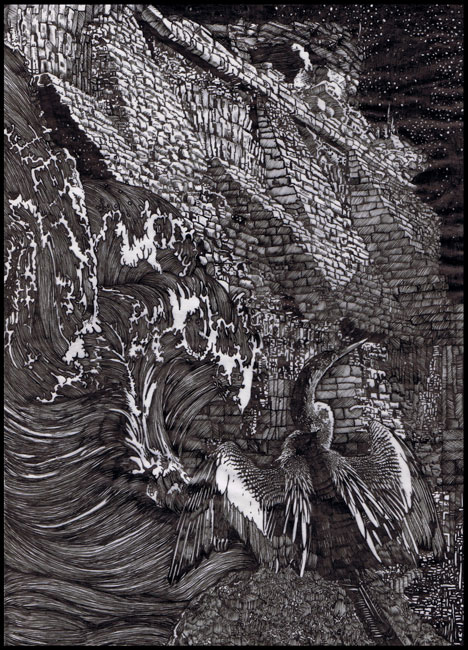
|
Time and Water, 2010
Time and Water is de titel van een van mijn favoriete IJslandse gedichten. De tekening gaat niet over de inhoud van het gedicht, maar over water als de vroedvrouw van de tijd, en hoe het water de grote schenker van leven en dood is. Ze zeggen dat de aarde ooit was bedekt met water - hoe ging de tijd dan voorbij? Land stijgt en land daalt, maar de grote oceanen van de wereld zijn eeuwige goden van vrijgevigheid en toorn. Ik kom van een eiland, ik weet waar ik het over heb. In vergelijking met de oceanen is de mens maar een droom.
De structuur in deze tekening is een andere ode aan de elementen - de vogel vertegenwoordigt de tijd, en terwijl hij zijn vleugels droogt, wordt water overwonnen door de warmte van de zon (vuur) op de veren van de zeevogel (lucht), terwijl hij op de rots staat (aarde). |
| |
|
|
Conversation, 2007
This is one of my oldest drawings, and one of the drawings I’m most fond of. The same process applies here as it did in Ceremony - the drawing is worked from a documentation image of one of my performances. The background is from a photo I took of a tree in Switzerland.
It is about reworking an older piece of work in another medium, changing it completely. What appears to be an old woman (witch) handling some kind of explosive phallic device is actually me trying to make two balloons stay on a wooden stand under a spotlight
|
|
Conversation, 2007
Dit is een van mijn oudste tekeningen, en een van de tekeningen waar ik het meest van hou. Hetzelfde proces als in Ceremony geldt ook hier - de tekening is uitgewerkt vanuit een documentatiebeeld van een van mijn optredens. De achtergrond is van een foto die ik nam van een boom in Zwitserland.
Het gaat over het herwerken van een ouder werk in een ander medium, het volledig veranderen. Wat lijkt op een oude vrouw (heks) die een soort van explosief fallisch apparaat hanteert ben ik eigenlijk zelf terwijl ik twee ballonnen op een houten stellage onder een spot probeer te laten staan.
|
| |
|
|
The Great Hall of Solitude, 2007
The Great Hall of Solitude is basically an homage to a friend - the figure in the drawing is my friend the Icelandic painter Hafsteinn Michael Gudmundsson. I saw a interview he did in a magazine, and in the photo he looked so sad. When I inquired about his sadness it made me feel for him, so I decided to make him this drawing as a kind of long distance pat on the back. |
|
The Great Hall of Solitude, 2007
The Great Hall of Solitude is in feite een hommage aan een vriend – de figuur in de tekening is mijn vriend de IJslandse schilder Hafsteinn Michael Gudmundsson. Ik zag een interview van hem in een tijdschrift, en op de foto zag hij er zo verdrietig uit. Toen ik informeerde over zijn verdriet voelde ik mee met hem, dus besloot ik deze tekening voor hem te maken als een soort van lange-afstand klopje op de rug |
| |
|
|
Inception, 2008
The head of the figure comes from a photograph of a sculpture I made in 2004 - and the rest of the body is improvised. This drawing was inspired by one of my favourite artists, Alfred Floki. The work is about ritual sex - the priest inseminates the cup with semen from his mouth. The background patterns are from Persian mosaics |
|
Inception, 2008
Het hoofd van de figuur komt uit een foto van een sculptuur die ik heb gemaakt in 2004 - en de rest van het lichaam is geïmproviseerd. Deze tekening was geïnspireerd op een van mijn favoriete artiesten, Alfred Floki. Het werk gaat over rituele seks- de priester bevrucht de beker met sperma uit zijn mond. De achtergrondpatronen zijn gebaseerd op Perzische mozaïeken. |
| |
|
|
Making Plans for Nigel, 2009
Making Plans for Nigel is a title I lifted from a song by XTC called 'We’re only making plans for Nigel'. You can hear the whole lyric on YouTube, it’s a chilling affair indeed. The image is basically about perception, and how we perceive the people in power. The source image is of Margaret Thatcher with a sleepy eye, making bets in a casino. This in itself is alarming - when the people we elect (or are selected) as our leaders portray human weaknesses or frailties. The prime minister of England should not be gambling with a Whiskey bottle in the foreground should she? These people have, amongst other things, the launch codes to nuclear arms, enough to destroy the world a thousand times over. It makes me wonder about the decision making process in the circles of power. Thatcher made thousands of people unemployed and is generally regarded by the public in England as the worst prime minister ever, yet the royal family has decided to give her a royal burial, even though she is still alive. There is something seriously wrong with that. It tells me that there is a huge division between those in power and the people they are supposed to care for - talk about a slap in the face.
“We are only making plans for Nigel,
We only want what’s best for him,
We are only making plans for Nigel,
He has his future in British steel” |
|
Making Plans for Nigel, 2009
Making Plans for Nigel is een titel die ik haalde uit een lied van XTC genaamd 'We’re only making plans for Nigel'. Je kunt de hele tekst horen op YouTube, het is inderdaad een ijzingwekkende affaire. Het beeld gaat in feite over de waarneming, en hoe we machthebbers zien. Het basisbeeld is van Margaret Thatcher, met een slaperig oog, die aan het gokken is in een casino. Dit is op zich verontrustend - wanneer de mensen die we kiezen (of selecteren) als onze leiders menselijke gebreken of zwakheden vertonen. De minister-president van Engeland mag niet gokken met een fles whisky op de voorgrond, toch? Deze mensen hebben kennis van, onder andere, de lanceringcodes van nucleaire wapens, genoeg om de wereld duizend keer te vernietigen. Het doet me nadenken over de besluitvorming in de kringen van de macht. Thatcher maakte duizenden mensen werkloos en wordt door het publiek in Engeland algemeen beschouwd als de slechtste premier ooit, maar de Koninklijke familie heeft besloten om haar een Koninklijke begrafenis te geven, hoewel ze nog in leven is. Daar is iets ernstig mis mee. Het laat zien dat er een enorme kloof is tussen de machthebbers en de mensen waarvoor ze geacht worden te zorgen - wat een klap in het gezicht.
“We are only making plans for Nigel,
We only want what’s best for him,
We are only making plans for Nigel,
He has his future in British steel” |
| |
|
|
Migrating Where? , 2008
Migrating Where? comes from an environmental concern. If we don’t check our behaviour we will drown this world in shit, that’s a fact. The plastic consumption of the society that we have built is staggering. I hope not - but one day the migrating birds of the world will take to the sky, heading south, and have no place to land on because they will not recognise the trash heap we have made of the world.
Yes, quite a Nihilistic thought for a beautiful image.
|
|
Migrating Where? , 2008
Migrating Where? komt voort uit een bezorgdheid over het milieu. Als we ons gedrag niet controleren zullen we deze wereld verdrinken in de stront, dat is een feit. Het verbruik van plastic in de maatschappij die we hebben opgebouwd is onthutsend. Ik hoop van niet - maar op een dag zullen de migrerende vogels van de wereld wegvliegen, naar het zuiden, en geen plaats hebben om te landen, omdat ze de vuilbelt die we van de wereld hebben gemaakt niet zullen herkennen.
Ja, een nogal nihilistische gedachte voor een mooi beeld.
|
| |
|
|
Embrace God, End Religion, 2008
Religion has ruined God’s credibility. The Vatican is a terrible public relations office for God. Now people all over the world confuse the divine spirit (or God) with religion and all the horrible mess it’s responsible for. How dumb can one species be - to worship the same god through different manuals and think that’s reason enough to be at each other’s throats? The latest horror show in this string of horror shows is what has been happening in the Catholic church. God is innocent. I subscribe to Tolstoy’s version of the divine, he simply said that he did not need the spectacles of the church to see God, and I agree. Who do these people think they are? Do they think God is a franchise they alone have the right to? How laughable, arrogant and sad.
|
|
Embrace God, End Religion, 2008
De religie heeft Gods geloofwaardigheid kapotgemaakt. Het Vaticaan is een verschrikkelijke public relations bureau voor God. Nu verwarren mensen over de hele wereld de goddelijke geest (of God) met religie en de verschrikkelijke puinhoop waar ze verantwoordelijk voor is. Hoe dom kan een soort zijn - om dezelfde God aanbidden door middel van verschillende handboeken en te denken dat dit reden genoeg is om elkaar naar de keel te staan? De nieuwste griezelshow in deze horrorreeks is wat er nu gebeurd in de katholieke kerk. God is onschuldig. Ik onderschrijf de visie van Tolstoj betreffende het goddelijke, hij zei eenvoudigweg dat hij niet de bril van de kerk nodig had om God te zien, en ik ben het daarmee eens. Wie denken deze mensen dat ze zijn? Denken ze dat God een franchise is waar zij alleen recht op hebben? Hoe belachelijk, arrogant en verdrietig. |
| |
|
|
The Mine, 2007
I lifted this image wholesale from a book I have about photography. To me it’s about slavery - no one in this day and age should have to labour at such dehumanising work. What you see is a human conveyor belt. If I remember correctly it’s from a gold mine in Brazil.
When I looked at the original image I felt the same as I do when I see soldiers’ graves - lost potential is all I can think of. The reason I put horns and a whip to the foreman is because I thought the image was just like Dante’s description of hell, where the sinners are forced to carry out a meaningless task for all eternity as punishment for their sins. The difference is that this is (was) an actual place on earth.
|
|
The Mine, 2007
Ik nam deze afbeelding klakkeloos over uit een boek over fotografie. Voor mij gaat dit over de slavernij - niemand zou vandaag de dag moeten zwoegen op zo'n mensonterende manier. Wat je ziet is een menselijke transportband. Als ik me goed herinner is het er een uit een goudmijn in Brazilië.
Toen ik keek naar de originele afbeelding voelde ik hetzelfde als wanneer ik graven van soldaten zie - verloren potentieel is alles wat ik kan bedenken. De reden dat ik de voorman hoorns en een zweep gaf omdat ik dacht dat het een beeld net was zoals in de beschrijving van Dante's hel, waar de zondaars gedwongen worden een zinloze taak uit te voeren tot in de eeuwigheid als straf voor hun zonden. Het verschil is dat dit een werkelijke plaats op aarde is (was). |
| |
|
|
The Sofa Painting, 2008
In Iceland we have a concept called the sofa painting - it originates from the 1950’s onwards, and refers to people who have just bought a new sofa and then go out looking for a painting that matches it. This concept was re-awoken in me when, after the Brussels Art Fair I was asked to go and hang a quite conceptual piece by one of Iceland’s 20th century masters at a woman’s villa. She had just bought a green sofa and wanted the piece above it - it made me laugh. So in my drawing the art takes revenge for this attitude by eating the sofa.
|
|
The Sofa Painting, 2008
In IJsland kennen we een concept dat het sofaschilderij heet- het is dateert minstens uit de jaren 1950 en verwijst naar mensen die net een nieuw bankstel hebben gekocht en dan op zoek gaan naar een schilderij dat erbij past. Dit concept werd opnieuw tot leven gewekt toen ik, na de Art Fair in Brussel, werd gevraagd om een nogal conceptueel werk van een van de 20 eeuwse IJslandse meesters op te gaan hangen in de villa van een vrouw. Ze had net een groene sofa gekocht en wilde het stuk erboven hangen - het deed me lachen. Dus in mijn tekening neemt de kunst wraak op deze houding door het bankstel op te eten.
|
| |
|
|
The Ruins, 2010
The Ruins is one of my favourite pieces. It is made of two photographs, one of a medieval ruins in a park in Leuven, and the other from a book I saw in an apartment I was staying at in Berlin. The Ruins is basically a warning, it warns the spectators that if their desires overtake their lives, the houses of their minds will fall into ruins. One must keep one's obsessions in check or they will destroy you. Captain Ahab is a good example, being an alcoholic or chronic gambler is another.
A ruin is always the last stage of something else. This drawing is in fact a mental portrait or psychological landscape; it also evokes a kind of mystery - what will happen if you enter the cave? What lurks in side? You don’t know until you try it, and then of course it’s too late.
|
|
The Ruins, 2010
The Ruins is een van mijn favoriete werken. Het is samengesteld uit twee foto's, een van een middeleeuwse ruïne in een park in Leuven, en de andere uit een boek dat ik zag in een appartement waar ik verbleef in Berlijn. The Ruins is in principe een waarschuwing, het waarschuwt de toeschouwers die als hun verlangens hun leven overheersen, de huizen van hun geest volledig zullen vervallen. Je moet je obsessies onder controle houden of ze zullen je vernietigen. Kapitein Ahab is een goed voorbeeld, of anders een alcoholist of een chronische gokker.
Een ruïne is altijd de laatste fase van iets anders. Deze tekening is in feite een mentaal portret of een psychologisch landschap, maar het roept ook een soort van mysterie op- wat zal er gebeuren als je de grot binnentreedt? Wat schuilt er binnenin? Je weet het niet totdat je het probeert, en dan is het natuurlijk te laat. |
| |
|
|
Janus, 2009
When I was making this drawing I was busy salvaging images from my daily life, using postcards, posters and basically any neglected or rejected image I could find in an effort to save them for the future - a kind of Noah’s ark effort. I would draw them and at the same time transport them from junk into works of art, giving them a new meaning in their new form. This was the working method when I made Janus, and applies more or less to most of my drawings. This working method together with my interest in ancient mythology makes (in my mind) a kind of contemporary mythology. For Janus I was also thinking about Darwin’s theory regarding the evolution of man. I concluded that if man came from apes (primates) then the gods must have come from super apes - which makes sense somewhere…
|
|
Janus, 2009
Toen ik deze tekening maakte was ik bezig met de beelden van mijn dagelijks leven samen te brengen, van ansichtkaarten en posters tot in feite elk veronachtzaamt of verworpen beeld dat ik kon vinden, in een poging om hen te redden voor de toekomst - een soort ark van Noach-actie. Ik tekende ze en tegelijkertijd transformeerde ik ze van rommel in kunstwerken, en gaf ze een nieuwe betekenis in hun nieuwe vorm. Dit was de werkwijze toen ik Janus maakte, en geldt min of meer voor de meeste van mijn tekeningen. Deze werkwijze maakt (in mijn ogen) samen met mijn interesse in oude mythologie een soort van hedendaagse mythologie. Voor Janus dacht ik ook na over de theorie van Darwin over de evolutie van de mens. Ik concludeerde dat als de mens van de apen (primaten) afstamde dan moeten de goden afkomstig zijn geweest van super apen - dat lijkt logisch op de een of andere manier...
|
| |
|
|
The Song in the Temple, 2009
The Song in the Temple is quite simply about love, and the necessity of having a song in your heart. The two pillars and arch are from an Albrecht Dürer woodcarving, and the bird in the centre is from an oriental restaurant flyer. On the shields you can see the sun and moon (male and female) and the tree of life and death. This simply symbolises that whoever one is, to have inspiration and to love life one must have a song in one's heart. That song can be anything - a love for another, ambition, creativity or countless other things. The bird itself is a double-edged symbol, it could be crying in pain or singing its most beautiful song. This is a nod to the fact that you can have the wrong song in your heart, which means that you will quite enthusiastically follow down a wrong path in life - and one never knows until one starts listening to oneself. This is where the notion of balance comes in again (I Gemini).
|
|
The Song in the Temple , 2009
The Song in the Temple gaat gewoon over de liefde, en de noodzaak van een lied in je hart te hebben. De twee pijlers en de boog zijn van een houtsnede van Albrecht Dürer, en de vogel in het centrum is van een brochure van een oosters restaurant. Op de schilden kan je de zon en de maan (mannelijk en vrouwelijk) zien en de boom van leven en dood. Dit symboliseert gewoon dat wie men ook is, om inspiratie te hebben en het leven lief te hebben moet men een lied in het hart hebben. Dat lied kan van alles zijn - de liefde voor elkaar, ambitie, creativiteit of talloze andere dingen. De vogel zelf is een tweesnijdend symbool, hij kan of huilen van de pijn of zijn mooiste lied zingen. Dit is een knipoog naar het feit dat je het verkeerde lied in je hart kunt hebben, wat betekent dat je heel enthousiast een verkeerde weg in het leven kan volgen - en je weet het nooit tot je begint te luisteren naar jezelf. Hier komt die notie van evenwicht ook weer terug (I Gemini). |
| |
|
|
| |
Most of the drawings are made in two sizes: 29 x 21 cm or 120 x 84 cm, ink on paper, with black frame |
|
